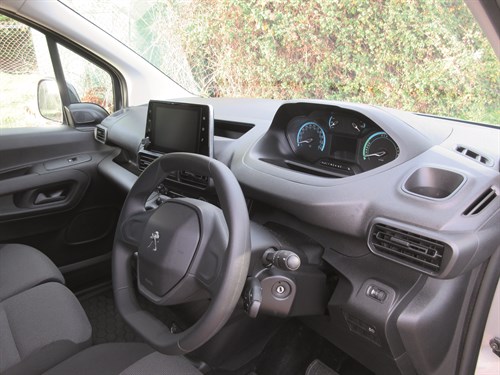- Further 4.25t electric van rule changes under consideration
- Arval research uncovers van fleet optimism
- Pre-orders open for new Nissan Interstar
- More than half of UK van drivers now believe EVs more cost effective than ICE, VW finds
- Public EV charging costs preventing adoption for some fleets, AFP says
- Ford Ranger Tremor review
- Inseego awarded Crown Commercial Service framework status
- ADVERTISEMENT FEATURE: Electrify and optimise: Digital solutions at the forefront of decarbonisation
- Fleets being pushed to take electric vans due to ZEV mandate, AFP reports
- Buying a used... Citroen Relay (2019)
The What Van? Road Test: Peugeot e-Partner (2021)
Date: Tuesday, January 24, 2023

Interior and equipment
While our test van did not boast satellite navigation, most of the features a driver is likely to require were present.
They included air-conditioning, electric windows, power-operated exterior mirrors, a driver’s airbag, and a 12V socket at the bottom of the dashboard. A USB port was positioned higher up.
The vehicle’s gear selector switch sits on a moulding that sticks out from the dashboard and also plays host to the electronic parking brake switch.
You can select from P for Park, R for Reverse, N for Neutral, D for Drive or B for Brake.
Using the last-named triggers the regeneration function, pumping charge into the battery every time you lift your foot off the brake pedal. At the same time it works rather like a heavy truck’s retarder, slowing you down
The intrusive moulding restricts the knee and leg-room offered to the occupant of the middle seat, and we cannot help but wonder whether it makes sense to shoehorn three seats into a cab of this size.
It means that shoulder room for all three occupants is limited, and we doubt that anybody sitting on the middle seat would want to travel more than a few miles given the potential discomfort.
Good to see that the heating and ventilation controls employ easy-to-identify, user-friendly, chunky switches. Far better than having to fiddle about with a touchscreen.
Storage facilities include a deep, lidded, but not lockable, glovebox which sits above a pair of shelves. You will find another shelf behind the 8in colour touchscreen which dominates the middle of the fascia and yet another in front of the gear selector.
Cup holders sit at each extremity of the dashboard with a third one within easy reach of the inboard passenger. Each door has two bins – one big, one small – and can accommodate a 1.5-litre flask or bottle.
There is more storage overhead.
Fold down the back of the middle seat and you have just created a handy pivoting desk. Pull the seat cushion up and you have just revealed a hidden compartment where you can stash your smartphone.
Hiding it there is better than leaving it lying around in the cab and risk getting it pinched. These features are included in the option pack referred to earlier that also includes lumbar adjustment for the driver’s seat.
The seat is height-adjustable, as is the steering wheel.
The conventional instrument panel tells you how much range you have got left, whether you are driving economically, and if regeneration is taking place.
It also tells you which drive mode you are in; Eco, Normal or Power. You use a switch next to the gear selector to make your selection.
The aforementioned touchscreen controls the DAB radio, and Bluetooth compatibility is included in the deal along with Apple Car play and Android Auto. Our demonstrator was covered by a six-month Free2Move Connect Fleet Telematics subscription which addresses everything from its whereabouts to whether it has developed a fault.
On-board safety devices include ABS, Electronic Stability Control, Hill Start Assist, Electronic Brake Assist, and Electronic Brakeforce Distribution. AVAS – Acoustic Vehicle Alerting System – warns vulnerable road users such as pedestrians and cyclists that the e-Partner is in the vicinity when it is being driven at low speeds around town.
Rear parking sensors were fitted, but are optional. They should be standard.
Electrically-assisted power steering is fitted along with disc brakes on all four wheels. MacPherson strut-type suspension is installed at the front and a torsion beam set-up is deployed at the back.
Complete with plastic trims, our e-Partner’s 16in steel wheels wore Michelin Green X 215/65 R16 tyres. An onboard monitoring system warns the driver if they start to lose pressure.
All the doors lock automatically at speeds above 7mph and the vehicle is protected by a Thatcham Category 1 alarm. The headlights illuminate automatically at dusk.
View The WhatVan Digital Edition


